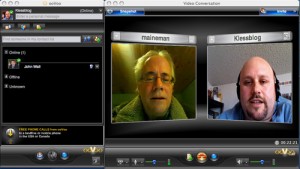 The more we interact online, the more disputes will happen in that medium. ODR (Online Dispute Resolution) is an extension of ADR (aka Alternative /Appropriate Dispute Resolution). ODR is becoming the defacto way to resolve cyberspace disputes. It only makes sense!
The more we interact online, the more disputes will happen in that medium. ODR (Online Dispute Resolution) is an extension of ADR (aka Alternative /Appropriate Dispute Resolution). ODR is becoming the defacto way to resolve cyberspace disputes. It only makes sense!
There is some interesting things going on in the field of ODR. In late October, I participated in the annual Cyberweek 2009 Coordinated by Ethan Katsh, Director of the National Center for Technology and Dispute Resolution. Cyberweek showcases ODR product simulations and demonstrations, facilitates plenary discussions related to ODR, and supports relevant real-time events. Since then, I’ve also been part of some interesting ODR conversations taking place on social media channels, including LinkedIn. In the past, I’ve posted on resolving conflict online vs. offline similarities and differences, based on my own experiences in a small claims context. Building on the above, here’s my list of the basic parameters that I think you should consider as you explore/adopt ODR in your own organization…
ODR parameters
Parties involved:
- Type of dispute (commercial, family, community, public)
- Suitability for mediation (power imbalances, perception of neutrality)
- Degree of stress for participants
- Complexity of dispute (# issues, # participants, cultural differences, previous history)
- Case/transaction volumes (one-off, high volume/frequency)
- Location of participants (global, local, hybrid)
- Timeline for resolving the dispute (ASAP? scheduling challenges (bringing parties together))
- FOIA, confidentiality requirements
3rd party (neutral) considerations:
- Type of 3rd party involvement (in-house facilitator, contract mediator, jury)
- 3rd party qualifications
- 3rd party availability (24×7, daytime only)
4th party (information communication technologies (ICT)) considerations:
- Extent that ICT provides structure to the process (vendor solution, custom design)
- Tool requirements (self-diagnostics, web conferencing, information management)
- Communication options (voice, video, written, mobile…)
- Communication frequency (Asynchronous, real-time interactive)
General considerations:
- Assessment of other resolution models (arbitration, tribunal, meet over a (virtual?) coffee)
- Degree of innovation (resolution process, use of ICT)
- Knowledge transfer expectations (to subsequent disputes, learning organization, disputing parties…)
- Resolution agreement (terms of agreement, sustainability, enforcement clauses …)
- Relationships (always!)
- Cost model
Some ODR Resources
In addition, for those considering ODR, there are numerous exciting ODR products, services, and ideas that are worth checking out:
- Established ODR packages/services: (e.g., Juripax, Smartsettle, Mediation Room)
- ODR services (e.g., Virtual Courthouse)
- crowd wisdom (e.g., eBay Community Court)
- conflict visualization (e.g., Debategraph)
- mediation for the masses? (e.g., MediateMe)
- Collaborative software; customize like you want for ODR (e.g., Google Wave)
- ODR/Mediation Portals (e.g., ODR.info, Mediate.com, ODR on Wikipedia)
- ODR/Mediation social media: listen or join in on interesting conversations; e.g., on LinkedIn, Twitter
What other parameters and/or resources would you add to the list?
If you enjoyed this post, please consider leaving a comment or subscribing to my blog. Always appreciated, Ben.
Photo credit: klessblog
MYY2TXH9DPHE

Speak Your Mind